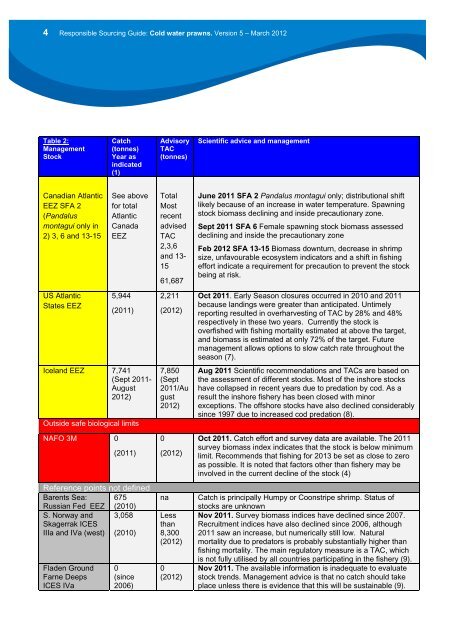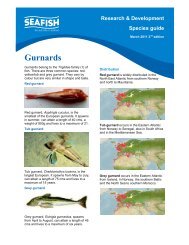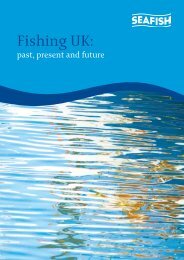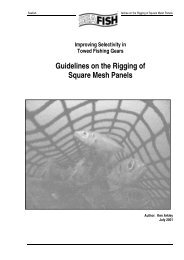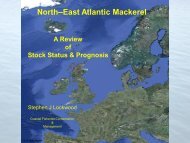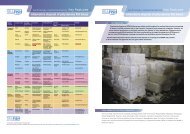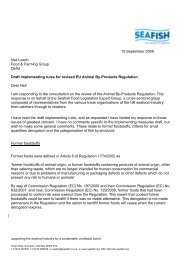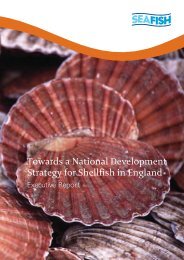Create successful ePaper yourself
Turn your PDF publications into a flip-book with our unique Google optimized e-Paper software.
4 Responsible Sourcing Guide: <strong>Cold</strong> <strong>water</strong> <strong>prawns</strong>. Version 5 – March <strong>2012</strong><br />
Table 2:<br />
Management<br />
Stock<br />
Catch<br />
(tonnes)<br />
Year as<br />
indicated<br />
(1)<br />
Advisory<br />
TAC<br />
(tonnes)<br />
Scientific advice and management<br />
Canadian Atlantic<br />
EEZ SFA 2<br />
(Pandalus<br />
montagui only in<br />
2) 3, 6 and 13-15<br />
See above<br />
for total<br />
Atlantic<br />
Canada<br />
EEZ<br />
Total<br />
Most<br />
recent<br />
advised<br />
TAC<br />
2,3,6<br />
and 13-<br />
15<br />
61,687<br />
June 2011 SFA 2 Pandalus montagui only; distributional shift<br />
likely because of an increase in <strong>water</strong> temperature. Spawning<br />
stock biomass declining and inside precautionary zone.<br />
Sept 2011 SFA 6 Female spawning stock biomass assessed<br />
declining and inside the precautionary zone<br />
Feb <strong>2012</strong> SFA 13-15 Biomass downturn, decrease in shrimp<br />
size, unfavourable ecosystem indicators and a shift in fishing<br />
effort indicate a requirement for precaution to prevent the stock<br />
being at risk.<br />
US Atlantic<br />
States EEZ<br />
5,944<br />
(2011)<br />
Iceland EEZ 7,741<br />
(Sept 2011-<br />
August<br />
<strong>2012</strong>)<br />
Outside safe biological limits<br />
NAFO 3M 0<br />
(2011)<br />
Reference points not defined<br />
Barents Sea: 675<br />
Russian Fed EEZ (2010)<br />
S. Norway and 3,058<br />
Skagerrak ICES<br />
IIIa and IVa (west) (2010)<br />
Fladen Ground<br />
Farne Deeps<br />
ICES IVa<br />
0<br />
(since<br />
2006)<br />
2,211<br />
(<strong>2012</strong>)<br />
7,850<br />
(Sept<br />
2011/Au<br />
gust<br />
<strong>2012</strong>)<br />
0<br />
(<strong>2012</strong>)<br />
na<br />
Less<br />
than<br />
8,300<br />
(<strong>2012</strong>)<br />
0<br />
(<strong>2012</strong>)<br />
Oct 2011. Early Season closures occurred in 2010 and 2011<br />
because landings were greater than anticipated. Untimely<br />
reporting resulted in overharvesting of TAC by 28% and 48%<br />
respectively in these two years. Currently the stock is<br />
overfished with fishing mortality estimated at above the target,<br />
and biomass is estimated at only 72% of the target. Future<br />
management allows options to slow catch rate throughout the<br />
season (7).<br />
Aug 2011 Scientific recommendations and TACs are based on<br />
the assessment of different stocks. Most of the inshore stocks<br />
have collapsed in recent years due to predation by cod. As a<br />
result the inshore fishery has been closed with minor<br />
exceptions. The offshore stocks have also declined considerably<br />
since 1997 due to increased cod predation (8).<br />
Oct 2011. Catch effort and survey data are available. The 2011<br />
survey biomass index indicates that the stock is below minimum<br />
limit. Recommends that fishing for 2013 be set as close to zero<br />
as possible. It is noted that factors other than fishery may be<br />
involved in the current decline of the stock (4)<br />
Catch is principally Humpy or Coonstripe shrimp. Status of<br />
stocks are unknown<br />
Nov 2011. Survey biomass indices have declined since 2007.<br />
Recruitment indices have also declined since 2006, although<br />
2011 saw an increase, but numerically still low. Natural<br />
mortality due to predators is probably substantially higher than<br />
fishing mortality. The main regulatory measure is a TAC, which<br />
is not fully utilised by all countries participating in the fishery (9).<br />
Nov 2011. The available information is inadequate to evaluate<br />
stock trends. Management advice is that no catch should take<br />
place unless there is evidence that this will be sustainable (9).


